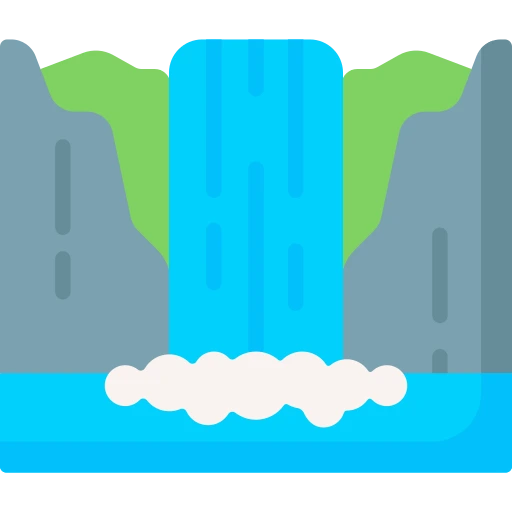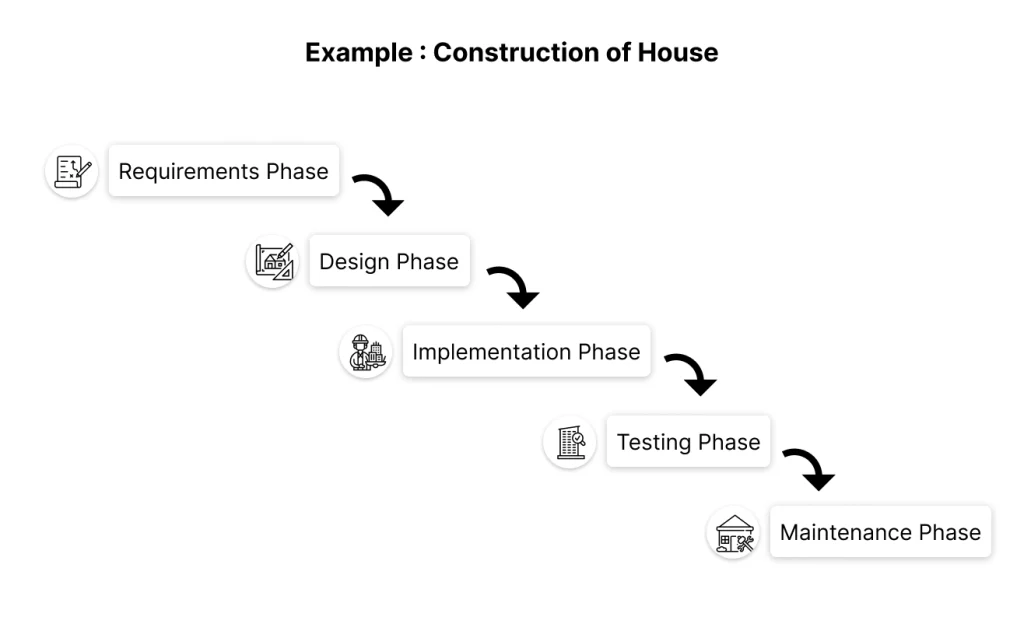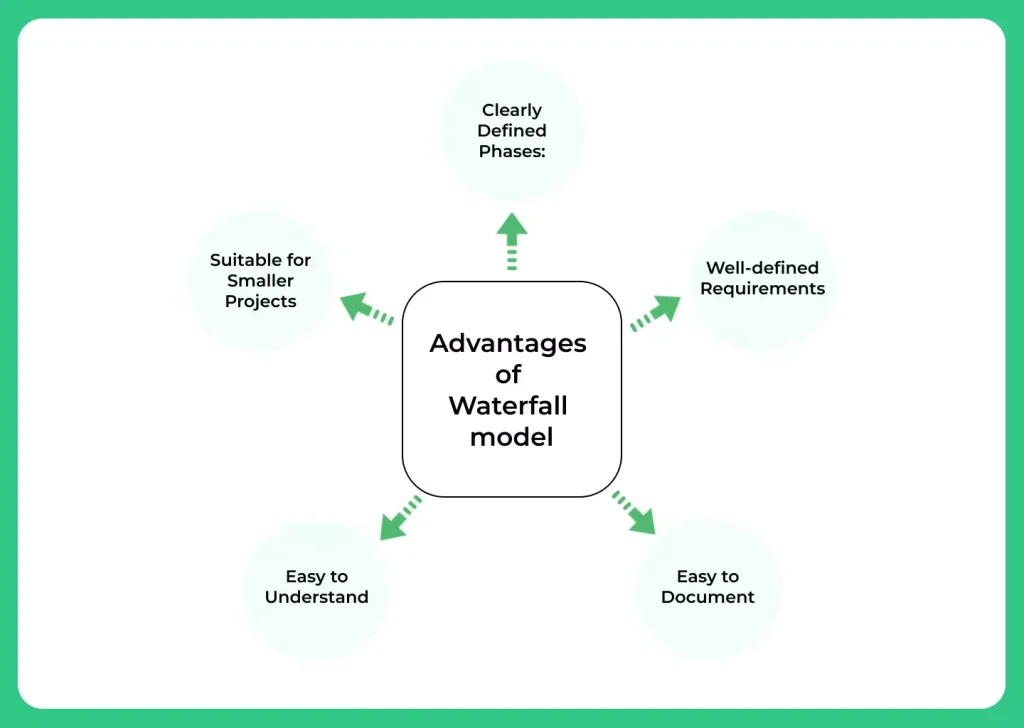Waterfall Model in SDLC
Introduction to Waterfall Model in SDLC?
The Waterfall model in SDLC is a linear software development process, in which development is seen as flowing steadily downwards like a waterfall through the phases of Conception, Initiation, Analysis, Design, Construction, Testing, Production/Implementation, and Maintenance.

What is Waterfall Model in SDLC?
The Waterfall Method in Software Development Life Cycle (SDLC) is a traditional and straightforward approach to building software. Imagine a waterfall: it flows in one direction, from top to bottom, step by step. In the same way, the Waterfall Method involves completing one phase of a project before moving on to the next.
- It starts with gathering all the requirements, then designing the system, followed by implementation (coding), testing, deployment, and finally, maintenance.
- Each phase must be finished before the next one begins, and there’s little room for changes once a phase is completed.
- This method is best for projects where the requirements are clear from the start and unlikely to change.
It’s simple to understand and manage but can be less flexible if new ideas or changes come up during the project.
Processes in Waterfall Model in SDLC

In this model, the software development process is divided into a series of distinct phases, each of which has a specific goal. The phases are:
Requirements gathering and analysis:
This phase involves gathering requirements from stakeholders, analysing them, and documenting them.
Design:
In this phase, the software design is created based on the requirements gathered in the previous phase. This includes designing the overall architecture of the software, as well as the individual components and their interfaces.
Implementation:
In this phase, the software is actually developed and coded.
Testing:
In this phase, the software is tested to ensure that it meets the requirements and is free of defects.
Deployment:
In this phase, the software is deployed and made available to users.
Maintenance:
After the software is deployed, it enters the maintenance phase, where it is updated and maintained to fix defects, add new features, and address changing user needs.
Waterfall Model Example
Waterfall model has different phases :
- Requirements Phase
- Design Phase
- Implementation Phase
- Testing Phase
- Maintenance Phase
Example :
- Imagine you are building a house using the Waterfall model. First, you make a detailed plan of the house, including the design and materials (this is the requirements phase).
- Once the plan is set, you create a blueprint, outlining how everything will look and function (design phase).
- Next, the construction team builds the house according to the blueprint (implementation phase).
- After the house is built, inspectors check everything to ensure it’s safe and meets the standards (testing phase).
- Finally, you move into the house and make any necessary repairs over time (maintenance phase).
In this example, each step must be completed before moving on to the next. You can’t change the design once construction starts, similar to how the Waterfall model works in software development. It’s a linear and organized process but doesn’t allow much flexibility for changes.

Waterfall Model vs Agile
Here’s the difference between the Waterfall model and Agile in simple points:
Process Flow:
- Waterfall: Follows a linear, step-by-step process.
- Agile: Uses an iterative approach with small cycles called sprints.
Flexibility:
- Waterfall: Little room for changes once a phase is completed.
- Agile: Easily adapts to changes throughout the project.
Project Phases:
- Waterfall: Each phase (planning, design, coding, testing) is completed before moving to the next.
- Agile: All phases happen within each sprint, with continuous reviews and adjustments.
Customer Involvement:
- Waterfall: Customer involvement is mostly at the beginning and end of the project.
- Agile: Frequent customer feedback and involvement throughout the project.
Best Suited For:
- Waterfall: Projects with well-defined and unchanging requirements.
- Agile: Projects where requirements may change or evolve.
Ideal Situations for Using the Waterfall Method
- Clear Requirements: Use Waterfall when project requirements are well-defined and unlikely to change. You know exactly what needs to be done from the start.
- Simple Projects: It’s a good choice for straightforward projects with few complexities or risks.
- Fixed Deadlines: If the project has strict timelines and each phase needs to be completed in a specific order, Waterfall is effective.
- Limited Customer Involvement: When the customer doesn’t need to provide feedback throughout the project, the Waterfall model works well.
- Regulatory Projects: For projects that must meet strict legal or regulatory requirements, Waterfall ensures everything is documented and followed step by step.
In short, use Waterfall when the path is clear, the project is simple, and changes are unlikely.
Advantages of Waterfall Model

The Waterfall model is a linear approach to software development, in which the development process follows a strict sequence of steps. This model has a number of advantages, including:
Clearly defined phases:
The Waterfall model breaks down the development process into distinct phases, which makes it easier to manage and track progress. Each phase has specific deliverables and milestones, which helps to ensure that the project stays on track.
Well-defined requirements:
The Waterfall model requires that all requirements be defined up front, before the project begins. This helps to ensure that the project team has a clear understanding of what needs to be delivered, and can plan accordingly.
Easy to document:
The Waterfall model’s linear approach makes it easy to document the progress of a project. This can be helpful for communication with stakeholders and for future reference.
Easy to understand:
The Waterfall model’s linear approach is easy to understand, even for those who are not familiar with software development. This makes it an accessible model for stakeholders who may not have a technical background.
Suitable for smaller projects:
The Waterfall model is well-suited for smaller projects, where the requirements are well-defined and there is little need for flexibility.
Disadvantages of Waterfall Model
Lack of feedback
Lack of collaboration
Long lead times
Limited visibility
There are several disadvantages of the Waterfall model in the software development life cycle (SDLC):
Inflexibility:
The Waterfall model is a linear model that follows a strict sequence of steps. This means that changes to the project scope or requirements cannot be easily accommodated, as they require going back to earlier stages in the process. This can lead to delays and increased costs.
Lack of feedback:
The Waterfall model does not allow for much feedback from users or stakeholders until the end of the process. This can lead to issues that are not identified until late in the development cycle, which can be costly to fix.
Lack of collaboration:
The Waterfall model tends to be more geared towards individual tasks and responsibilities, rather than collaboration between team members. This can lead to communication breakdowns and a lack of shared understanding.
Long lead times:
The Waterfall model can take a long time to complete, as each stage must be completed in sequence before moving on to the next. This can lead to delays and missed deadlines.
Limited visibility:
The Waterfall model can be difficult for stakeholders to understand and follow, as they may not have visibility into the progress of the project until later stages. This can lead to misunderstandings and unrealistic expectations.
Applications of Waterfall Model - SDLC
Here’s where the Waterfall Method is applied:
- Software Development: Used for projects with clear, unchanging requirements, like building a basic app or system.
- Manufacturing: Ideal for production processes where each step needs to be completed before moving on, like assembling a product.
- Construction Projects: Applied when building structures, where planning, design, and construction follow a specific order.
- Government Projects: Suitable for projects with strict regulations and documentation requirements, where every phase must be followed precisely.
- Education and Training: Used to develop training programs or educational content where the material is structured and sequential.
- In simple terms, the Waterfall Method is best applied to projects where each phase needs to be completed in a specific order, and changes are unlikely to occur.
To Wrap it Up :
The Waterfall Model is one of the earliest and most straightforward software development methodologies. Its linear and structured approach makes it easy to understand and manage, especially for projects with clearly defined requirements. While it may not be suitable for every project – particularly those requiring frequent changes or client feedback – it remains a reliable choice for small to medium-sized projects with fixed scopes.
FAQ's
While Waterfall is rigid by nature, small adjustments can introduce limited flexibility. For example, adding a “feedback checkpoint” after key phases or incorporating a mini-review before final deployment can help catch issues early. This hybrid approach is sometimes called “Water-Scrum-Fall.”
Yes, one strength of Waterfall is its structured documentation. Reusing requirement docs, test cases, and design templates from similar past projects can save time. However, these templates must be adapted to the current project context to avoid outdated assumptions.
In Waterfall, team roles are usually more specialized and siloed. For instance, analysts focus only on requirements, developers only on coding, and testers only on validation. Unlike Agile, where cross-functional collaboration is key, Waterfall relies on handovers between distinct roles.
Waterfall sets clear client expectations upfront, which can be both a strength and a limitation. While it avoids scope creep, it also limits the client’s ability to evolve the product vision during development, which can create tension if market needs shift mid-project.
Get over 200+ course One Subscription
Courses like AI/ML, Cloud Computing, Ethical Hacking, C, C++, Java, Python, DSA (All Languages), Competitive Coding (All Languages), TCS, Infosys, Wipro, Amazon, DBMS, SQL and others




Login/Signup to comment